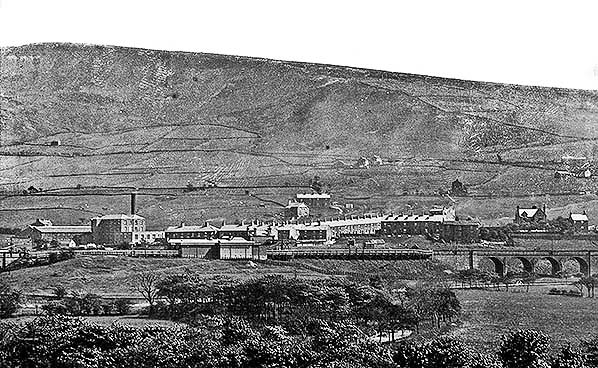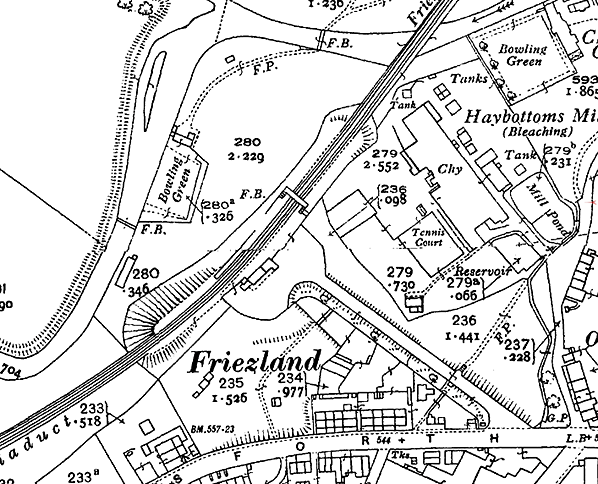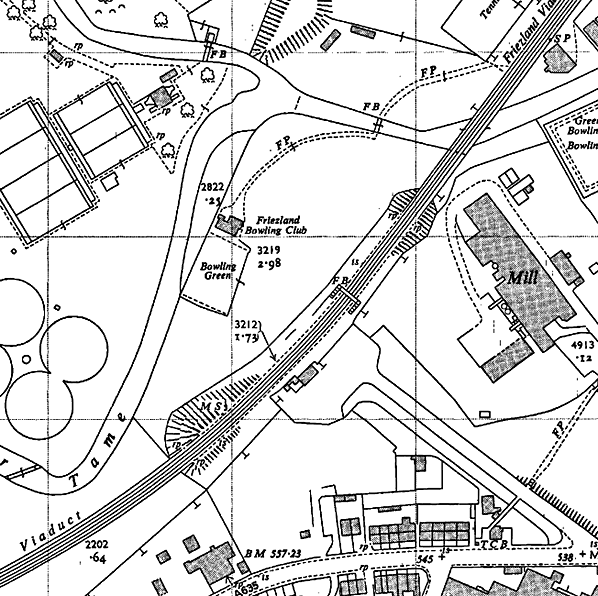
Station Name: FRIEZLAND[Source: Alan Young]
 Looking south-east towards Friezland station from a point close to Greenfield station c1910. Friezland station is seen between Friezland Viaduct (right) and Greenfield Viaduct (left), with the rear of the down platform shown clearly. The waiting room block and down platform are both constructed of timber. The footbridge connecting the platforms is visible in front of the station building, which adjoins the up platform. It is assumed that this platform was also of timber construction, like all others on the Micklehurst Loop. Left of the station, the large building with the chimneystack is Haybottoms bleaching mill. The desolate heights of Saddleworth Moor provide a dramatic backdrop.
Photo from Peter Fox 'Old Saddleworth' collection   1906 1: 2,500 OS map. Friezland passenger station stands at the end of the un-named Station Road. The two platforms are shown, with the station house and offices on the up (south-east) side and a waiting shed on the opposite platform. The extent of the awnings on both platforms is shown by pecked lines and shading. A footbridge connects the two platforms; the steps on the south-east side are directly in front of the station house. At the ends of each platform the land falls away, requiring short embankments, and in both directions the railway passes onto viaducts. The north-easterly one is labelled ‘Friezland Viaduct’, but is more commonly known as Greenfield Viaduct; the other viaduct is referred to in the present text as Friezland Viaduct. The locality has a scattering of industry – a couple of mills are within easy walking distance of the station - and a mixture of terraces, cottages and more opulent houses. The goods station is several hundred yards from the passenger station, reached by a long approach track. The facilities are on the up side, south-east of the running lines and comprise four goods loops, two passing through the shed (warehouse), and there are also two dead-end sidings. The weigh office (WM=Weighing machine) is attached to the north-eastern end of the warehouse and Friezland signal box is on the down side.
 1932 1: 2,500 OS map. Friezland passenger station closed in 1917 and is no longer named. The outlines of its two platforms are discontinuous suggesting that they have been partially demolished, and the down platform building is no longer shown, but the main building is still in place (and remains so in 2015). The original footbridge has been removed, but a new one to the north-east has been installed: it is not clear what is reached to the north-west of the railway by this footbridge as no pathway extends beyond it.
 1932 1: 2,500 OS map. 0.jpg) Looking north-east circa 1906 towards Greenfield Viaduct on the Micklehurst Loop (between Uppermill and Friezland stations); the largest arch is passing over Chew Brook. The viewpoint is the path which connected the Oldham platform of Greenfield station (on the original Huddersfield-Manchester line) to Oldham Road. In the foreground is the Greenfield to Oldham branch; the main line is beyond the two LNWR carriages.
Photo from Peter Fox 'Old Saddleworth' collection 2.jpg) On 10 August 1909 the 9.20am up passenger express from Huddersfield to Stockport was hauled by LNWR 0-6-2 tank No.1608. When approaching Friezland Viaduct, west of the station, the engine and its three carriages were derailed, possibly because of excessive speed down the gradient from Uppermill. The whole train continued along the viaduct, coming to rest 135yd beyond the south end. The engine had fallen on its right-hand side (which was badly damaged) and then spun round after being hit by the first carriage, so the engine ended up facing the opposite way to its direction of travel, yet in an upright position. Driver William Turton and Fireman James Oates were both killed and the guard and 13 of the 40 passengers were injured. The title of the photograph captures the confusion over names. Greenfield is on the ‘old’ Diggle-Stalybridge line, and Friezland is the station serving the village of Greenfield on the Micklehurst Loop.
Photo from Peter Fox 'Old Saddleworth' collection 3.jpg) A local firm cashed-in on the accident, producing this postcard to commemorate the Friezland ‘Remarkable Railway Smash’. Apparently a local photographer did one better and gave a ‘magic lantern’ show of the disaster in Stalybridge on the evening of 10 August 1909, the day of the accident. The number of injured passengers is stated as 13 in a later source.
Photo from Peter Fox 'Old Saddleworth' collection 1.jpg) An aerial view of Mossley Gasworks circa 1951. Early in the LMS era Mossley Gas Works became an important user of the Micklehurst Loop. Located a short distance south of the 140yd Royal George Tunnel, about ½-mile south-west of Friezland goods station, the gas works was built between 1926 and 1931 on the down side of the line. Sidings were installed to serve the works, with connections to the Micklehurst Loop in both directions; access was controlled by Friezland Gas Sidings signal box on the up side of the through lines.
Photo from David Bielby collection 3.jpg) Looking north-east from Friezland station towards Greenfield Viaduct in November 1970; a parapet of the viaduct is visible. The concrete footbridge was installed in the inter-war years to replace the station footbridge (which was located close to where the photographer is standing) but with the rails having been recently removed it would appear now to be neither use nor ornament. The station building is off the picture to the right.
Photo by John Mann 5.jpg) Demolition of Greenfield Viaduct is under way near Greenbridge Lane in 1975.
Photo from Peter Fox 'Old Saddleworth' collection 11.jpg) Friezland passenger station building looking north-west in May 2015, almost a century after the station closed. The drive follows the course of the former Station Road. The building is of the same style as at the other three Micklehurst Loop stations. The house looks attractive but many changes have been made to its appearance since it was in railway use, including the painting of the red brick in eau-de-Nile and replacement windows. The platforms were behind the building, and nothing is visible of them.
Photo by Alan Young 12.jpg) Friezland passenger station building looking west in May 2015, almost a century after the station closed. The building is of the same style as at the other three Micklehurst Loop stations. The house looks attractive but many changes have been made to its appearance since it was in railway use, including the painting of the red brick in eau-de-Nile and replacement windows. The platforms were behind the building, and nothing remains of them.
Photo
by Alan Young
13.jpg) Fiezland passenger station building looking south-west in May 2015 from the site of the former up platform. Trees are occupying the railway trackbed.
Photo by Alan Young
|
 Friezland station house and office range were on the up (south-east) platform and a waiting shelter stood on the down platform, displaced north-east of, rather than facing, the main building. Awnings were provided on both platforms. The design of the station house was similar to that of the other three on the Micklehurst Loop. It was constructed of brick, probably red with string courses of blue engineering brick and pale stone lintels. The dignified two-storey structure was almost square in plan, and single-storey office / waiting room ranges extended on both sides. The roof of the station house was hipped and slated and the office range probably had similar roofing, with restrained cresting and finials. A cornice was provided using a row of bricks set at 45⁰ as dentils. The original chimneystacks were probably of blue brick. The entrance from the road to the house was centrally placed, probably sheltered by a small sloping porch, with pairs of tall rectangular windows either side. Apart from the opening above the doorway, other windows were also in pairs.
Friezland station house and office range were on the up (south-east) platform and a waiting shelter stood on the down platform, displaced north-east of, rather than facing, the main building. Awnings were provided on both platforms. The design of the station house was similar to that of the other three on the Micklehurst Loop. It was constructed of brick, probably red with string courses of blue engineering brick and pale stone lintels. The dignified two-storey structure was almost square in plan, and single-storey office / waiting room ranges extended on both sides. The roof of the station house was hipped and slated and the office range probably had similar roofing, with restrained cresting and finials. A cornice was provided using a row of bricks set at 45⁰ as dentils. The original chimneystacks were probably of blue brick. The entrance from the road to the house was centrally placed, probably sheltered by a small sloping porch, with pairs of tall rectangular windows either side. Apart from the opening above the doorway, other windows were also in pairs.  Micklehurst closed to passengers in 1907, followed by Staley & Millbrook in 1909, but Friezland and Uppermill remained open for several years more. The April 1910 timetable, above, shows a reduced service in comparison to 1895, particularly in the down direction; no trains called on Sunday. On 1 January 1917 these two remaining stations – along with a number of Britain’s quieter stations – were closed to release staff for military service in the ‘Great War’. Some of these stations re-opened after the war was over, but Friezland and Uppermill did not. Passenger trains continued to use the Micklehurst Loop, but no record has been seen of calls being made after 1917 at any of the intermediate stations, even for excursions. After the station closed to passengers its footbridge was dismantled and a concrete footbridge was built prior to 1932 to enable pedestrians to cross the line which still carried freight and occasional passenger trains.
Micklehurst closed to passengers in 1907, followed by Staley & Millbrook in 1909, but Friezland and Uppermill remained open for several years more. The April 1910 timetable, above, shows a reduced service in comparison to 1895, particularly in the down direction; no trains called on Sunday. On 1 January 1917 these two remaining stations – along with a number of Britain’s quieter stations – were closed to release staff for military service in the ‘Great War’. Some of these stations re-opened after the war was over, but Friezland and Uppermill did not. Passenger trains continued to use the Micklehurst Loop, but no record has been seen of calls being made after 1917 at any of the intermediate stations, even for excursions. After the station closed to passengers its footbridge was dismantled and a concrete footbridge was built prior to 1932 to enable pedestrians to cross the line which still carried freight and occasional passenger trains.
thumb16.jpg)
thumb15.jpg)

 Home Page
Home Page